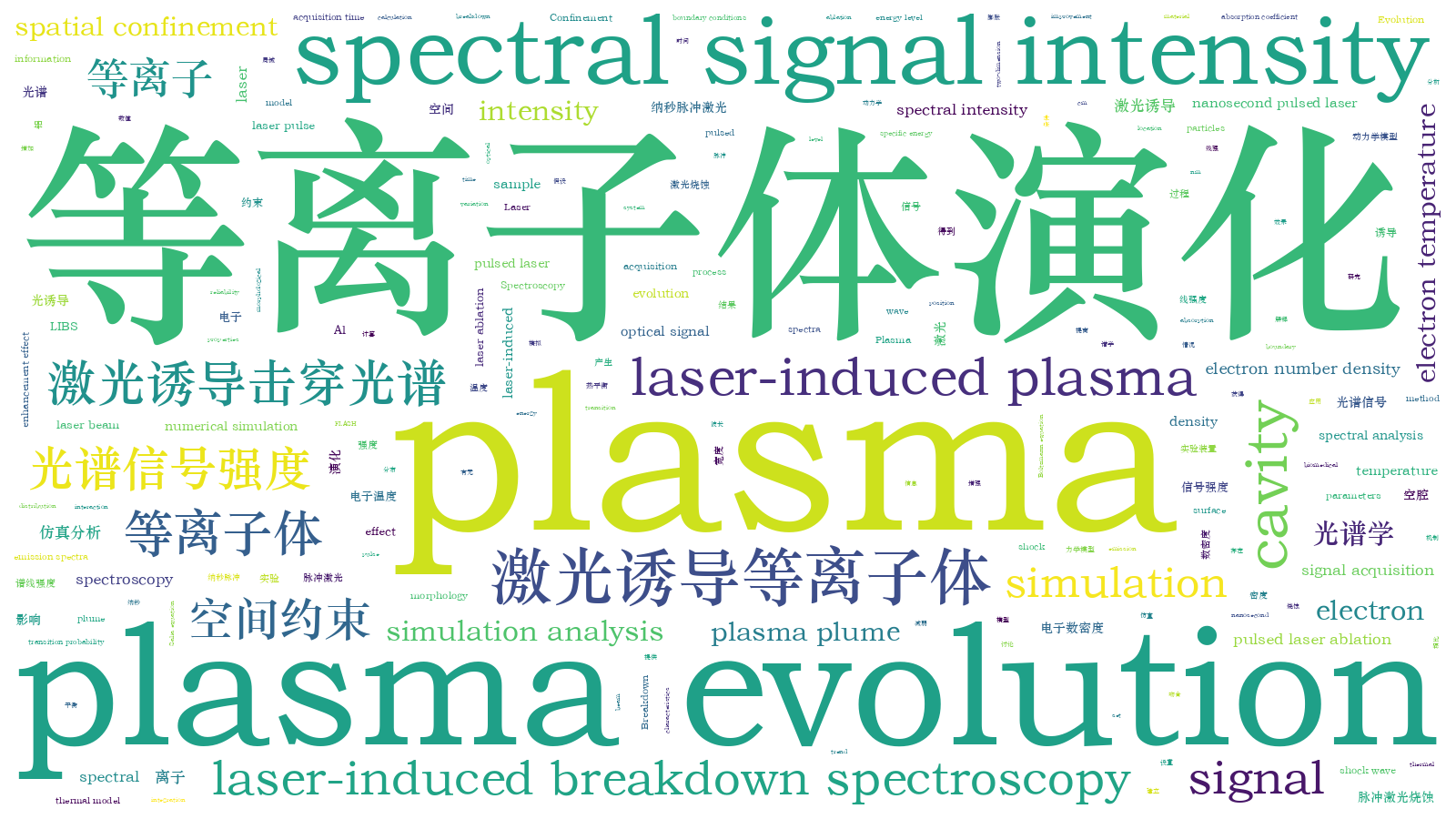空间约束对激光诱导等离子体演化和光谱的影响
Laser-induced breakdown spectroscopy (LIBS) is a valuable element analysis method that has been widely applied in many fields including biomedical, industrial, and environmental analysis. It uses a pulsed laser beam to interact with the sample and produces a plasma plume above the sample surface. The emission spectra of the specific elements can be obtained from the plasma, and element compositions and contents of the sample can be gained by spectral analysis. The properties of plasma and sample analysis depend on the related parameters of the LIBS system, which includes the laser pulse and physical situation of the sample. Related works have been carried out to describe the effects of such conditions on laser-induced plasma through numerical simulation. Spatial confinement is an effective method to enhance LIBS signals. The plasma evolution, including its morphological characteristics, is affected by the presence of the cavity. The plasma confined by the cavity is physically modified, with its morphology changed, because of its interaction with the cavity walls. In this work, the effects of spatial confinement on plasma evolution and spectra in LIBS are investigated by the model. The laser-induced plasma plume of Al with or without the cavity is analyzed, and numerical information on the plasma particles is acquired during the expansion of plasma. In addition, the distributions of electron number density and electron temperature are studied. According to the plasma evolution data, the specific spectral signal intensities of the cases with different cavity widths are calculated. Under the same conditions as the simulation, experiments are performed to show the enhancement effect on signal intensity with the presence of the cavity and make a comparison with the simulation.
In this study, Al is employed as the sample material for the laser-induced plasma. Firstly, the initial conditions of the simulation process are determined, including relevant parameters of the incident laser, the spatial state of the sample (cavities with different sizes), and the boundary conditions of the simulation region. Given the state equation of the plasma evolution process and the simulation program FLASH, relevant data of the plasma can be obtained, including the plasma morphology and the spatial and temporal distributions of electron number density and electron temperature. Then, through the Saha equation and Boltzmann equation, the electron distribution information on the specific energy level can be further calculated. On the basis of the electron transition probability and absorption coefficient equation, the spectral intensity per unit can be acquired. After that, the overall spectral signal intensity is gained by the integration of the spectral signal of the acquisition region. In addition, experiments are conducted according to the parameters of the simulation, and the spectral signal intensities under different cavity widths are collected for further analysis combined with the simulation.
The plasma evolution is significantly different in the case with or without the cavity. When the cavity exists, the expansion of plasma is affected by cavity walls, and the plasma morphology varies (Fig. 3). At the position of 1.0 cm above the Al surface, both the electron temperature and electron number density are enhanced (Fig. 5). This is because the shock wave produced by the laser-induced plasma is reflected by the wall, and then the reflected shock wave acts on the plasma and raises collision probabilities of particles in the plasma, which increases the electron number density and electron temperature and eventually leads to improvement of the spectral signal. The spatial confinement effect on plasma also contributes to the increase in the spectral signal intensity, the enhancement effect depends heavily on cavity width, and the maximum signal intensity is obtained at the width of 1.4 cm (Fig. 8). In addition, the tendency of the spectral signal intensity collected by the experiments is in good agreement with the simulation, which demonstrates good reliability of the simulation (Fig. 9).
In the present study, a two-dimension thermal model for nanosecond pulsed laser ablation of Al is developed to investigate the effect of spatial confinement on plasma evolution. The simulation yields numerical information on the spatial and temporal distributions of the plasma affected by cavities with different sizes. It can provide a reference for selecting the appropriate optical signal acquisition time and location in the experiments and a credible interpretation of the experimental data. When a cavity is present, the temperature and density of the plasma are enhanced, and the enhancement degrades as the cavity enlarges. The spatial and temporal distributions of electron temperature and electron number density are also studied for the calculation of signal intensity. Compared with the situation without the cavity, the signal intensity is significantly improved when a proper cavity exists. The maximum signal intensity is obtained at the cavity width of 1.4 cm, and this value is drastically improved compared to the case without the cavity. The variation trend of signal intensity with cavity widths obtained by the experiments matches well with the simulation. Moreover, it is shown that the presence of a cavity does not improve the signal intensity in all cases. A larger cavity width leads to weaker enhancement of plasma temperature and density, and signal acquisition is slightly affected by the presence of the walls. Both the simulation and experimental results suggest that the intensity is lower than that of the situation without a cavity when the cavity width is set to 2.0 cm.
蔡亚超, 步扬, 王远航, 吴芳, 阎晓娜. 空间约束对激光诱导等离子体演化和光谱的影响[J]. 光学学报, 2023, 43(7): 0730001. Yachao Cai, Yang Bu, Yuanhang Wang, Fang Wu, Xiaona Yan. Effect of Spatial Confinement on Plasma Evolution and Spectrum in Laser-Induced Breakdown Spectroscopy[J]. Acta Optica Sinica, 2023, 43(7): 0730001.







